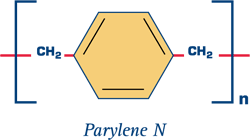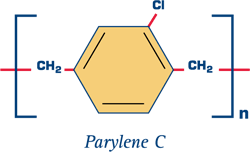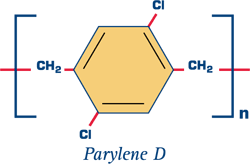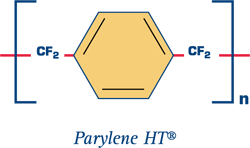Parylene Properties
SCS Parylene Properties
SCS Parylene conformal coatings are ultra-thin, pinhole-free polymer coatings that provide a number of high-value surface treatment properties such as excellent moisture, chemical and dielectric barrier properties, thermal and UV stability, and dry-film lubricity. These properties make SCS Parylene coatings the ideal choice for a number of applications throughout the medical device, electronics, transportation, defense and aerospace industries.
SCS Parylene coating properties that protect
Parylene is the generic name for members of a unique polymer series. These members (or variations of Parylene) each offer their own, slightly different, coating properties to engineers. Commercially available Parylene variants, along with their respective properties, include:
Parylene N
The basic member of the series, Parylene N, is poly(para-xylylene), a completely linear, highly crystalline material. Parylene N is a primary dielectric, exhibiting a very low dissipation factor, high dielectric strength, and a low dielectric constant invariant with frequency. The crevice-penetrating ability of Parylene N is second only to that of Parylene HT®.

Parylene C
Parylene C, the second commercially available member of the Parylene series, is produced from the same raw material (dimer) as Parylene N, modified only by the substitution of a chlorine atom for one of the aromatic hydrogens. Parylene C has a useful combination of electrical and physical properties, plus a very low permeability to moisture and corrosive gases.

Parylene D
Parylene D, the third member of the series, is produced from the same raw material as Parylene N, modified by the substitution of chlorine atoms for two of the aromatic hydrogens. Parylene D is similar in properties to Parylene C with the added ability to withstand slightly higher use temperatures.

Parylene HT®
Parylene HT replaces the alpha hydrogen atom of the N dimer with fluorine. This variant of Parylene is useful in high temperature applications (short term up to 450°C) and those in which long-term UV stability is required. Parylene HT also has the lowest coefficient of friction and dielectric constant, and the highest penetrating ability of the Parylenes.

ParyFree®
ParyFree®, the newest and a unique member of the series, replaces one or more hydrogen atoms of the Parylene N dimer with non-halogenated substituents. This halogen-free variant offers the advanced barrier properties of Parylene C and adds improved mechanical and electrical properties compared to other commercially-available Parylenes. ParyFree optimizes the critical combination of barrier, electrical and mechanical properties to provide robust protection against moisture, water, corrosive solvents and gases, while complying with halogen-free requirements of select industries worldwide.
Parylene C-UVF®
Because Parylene coatings are optically clear, there is an inherent level of difficulty involved in identifying if a component has been coated with Parylene. In the aerospace and defense industries, for example, where failure is not an option, customers require a method to guarantee that a component is indeed Parylene coated. SCS Parylene C-UVF coatings are formed when a special compound is incorporated into the Parylene C deposition process. The result is a coating that fluoresces under a black light, verifying that components are coated and ready for use, while maintaining the same electrical, mechanical and physical properties of Parylene C film.
microRESIST® Antimicrobial Parylene Technology
SCS microRESIST Antimicrobial Parylene Technology is a significant breakthrough that combines the benefits of biocompatible Parylene with antimicrobial properties to effectively eliminate harmful microorganisms on coated medical devices. microRESIST offers manufacturers reliable antimicrobial protection, having demonstrated greater than 5 Log reduction on 14 of the most common microorganisms. For more information on microRESIST, click here.
Putting SCS Parylene knowledge to work.
More detailed information regarding the Parylene variants, and their respective properties and benefits, can be found in the SCS Parylene Properties brochure, which is available for download in the SCS Technical Library. You can also find more information on SCS Parylene C-UVF® and market-specific brochures containing relevant properties and applications in the library.
If you have questions about specific SCS Parylene properties, test methods and procedures, or how SCS Parylenes can benefit your application, contact SCS online or call +1.317.244.1200.

